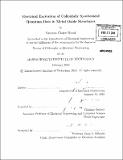| dc.contributor.advisor | Vladimir Bulović. | en_US |
| dc.contributor.author | Wood, Vanessa Claire | en_US |
| dc.contributor.other | Massachusetts Institute of Technology. Dept. of Electrical Engineering and Computer Science. | en_US |
| dc.date.accessioned | 2010-09-03T18:55:10Z | |
| dc.date.available | 2010-09-03T18:55:10Z | |
| dc.date.copyright | 2010 | en_US |
| dc.date.issued | 2010 | en_US |
| dc.identifier.uri | http://hdl.handle.net/1721.1/58454 | |
| dc.description | Thesis (Ph. D.)--Massachusetts Institute of Technology, Dept. of Electrical Engineering and Computer Science, 2010. | en_US |
| dc.description | Cataloged from PDF version of thesis. | en_US |
| dc.description | Includes bibliographical references (p. 163-172). | en_US |
| dc.description.abstract | This thesis develops methods for integrating colloidally synthesized quantum dots (QDs) and metal oxides in optoelectronic devices, presents three distinct light emitting devices (LEDs) with metal oxides surrounding a QD active layer, and uses these novel metal oxide based QD-LEDs to study mechanisms for electrical excitation of QDs. QD-LEDs have generated considerable interest for applications such as thin film displays with improved color saturation and white lighting with high color rendering index. This work demonstrates that air-stable metal oxides can be used to achieve QD-LEDs that have long shelf lives and operate at constant luminance in ambient conditions, unpackaged. Because metal oxides range from conductors to dielectrics, they can be used to develop a variety of different device architectures to explore mechanisms for electrical excitation of QDs. We report the first all-inorganic QD-LEDs with n- and p-type metal oxide charge transport layers and present design rules to enable systematic improvement of device efficiency. To shift away from direct charge injection as a means for electroluminescence (EL) in inorganic-based QD-LED structures, we develop a unipolar device architecture that presents the first evidence of field driven EL in QDs. To further explore this field driven excitation mechanism, we develop a structure that situates QDs between two insulating metal oxide layers. By eliminating the need for energy band alignment, these devices enable EL from QDs with emission peaks from 450 nm-1500 nm as well as from novel nanoparticles, such as phosphor doped-core/shell nanocrystals. | en_US |
| dc.description.statementofresponsibility | by Vanessa Claire Wood. | en_US |
| dc.format.extent | 172 p. | en_US |
| dc.language.iso | eng | en_US |
| dc.publisher | Massachusetts Institute of Technology | en_US |
| dc.rights | M.I.T. theses are protected by
copyright. They may be viewed from this source for any purpose, but
reproduction or distribution in any format is prohibited without written
permission. See provided URL for inquiries about permission. | en_US |
| dc.rights.uri | http://dspace.mit.edu/handle/1721.1/7582 | en_US |
| dc.subject | Electrical Engineering and Computer Science. | en_US |
| dc.title | Electrical excitation of colloidally synthesized quantum dots in metal oxide structures | en_US |
| dc.type | Thesis | en_US |
| dc.description.degree | Ph.D. | en_US |
| dc.contributor.department | Massachusetts Institute of Technology. Department of Electrical Engineering and Computer Science | |
| dc.identifier.oclc | 635482850 | en_US |

